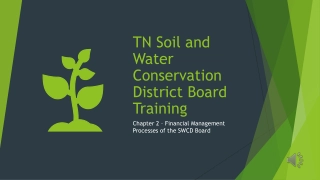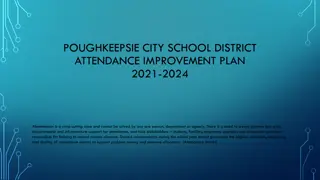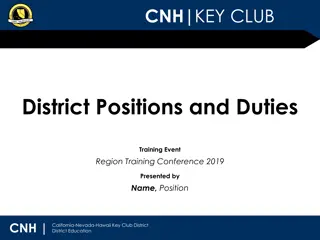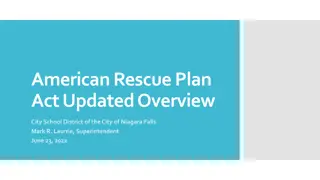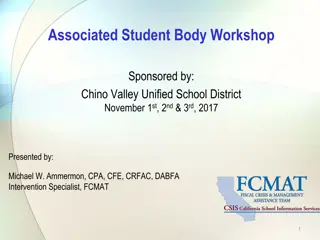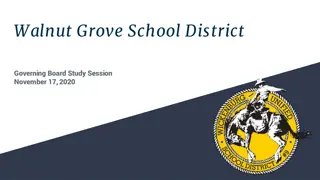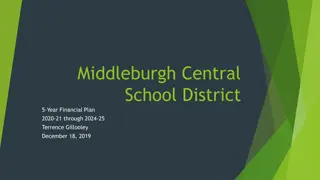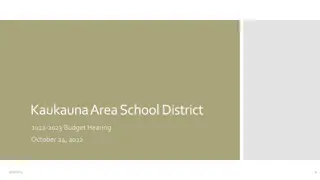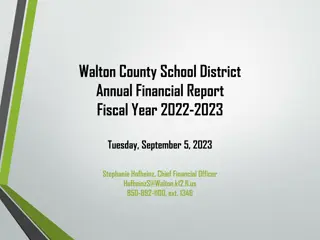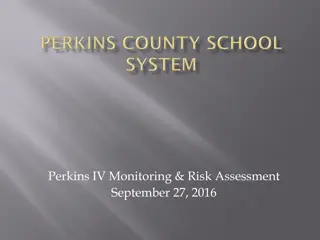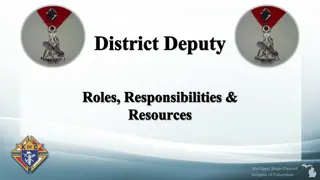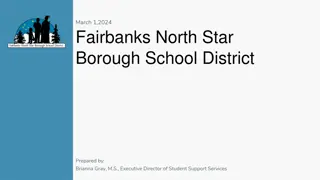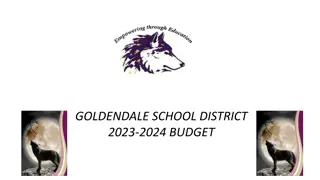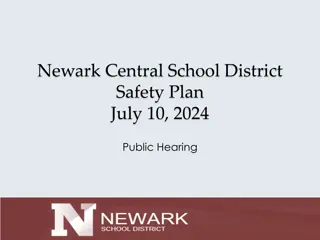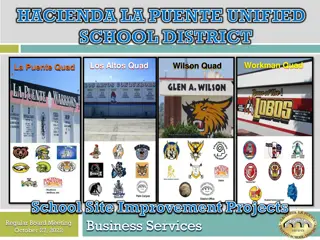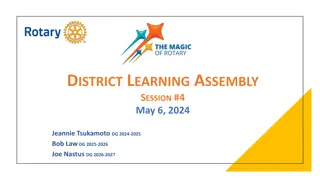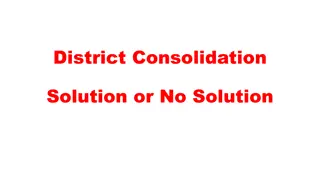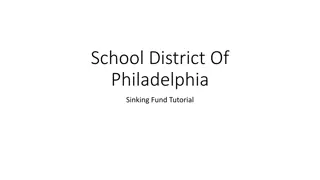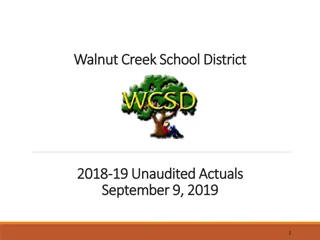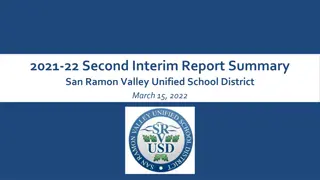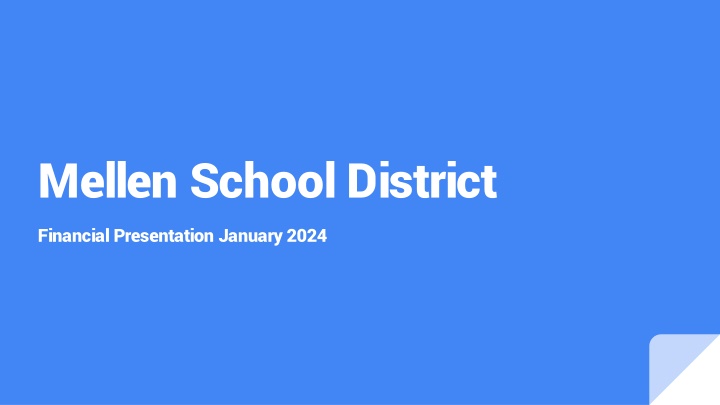
Mellen School District Financial Challenges and Budget Review 2024
"Explore the financial predicament of Mellen School District highlighted in the January 2024 presentation. Learn about budget constraints, per-pupil adjustments, budget reviews, programming evaluations, revenue sources, and expense summaries impacting the district's operations and future sustainability."
Download Presentation

Please find below an Image/Link to download the presentation.
The content on the website is provided AS IS for your information and personal use only. It may not be sold, licensed, or shared on other websites without obtaining consent from the author. If you encounter any issues during the download, it is possible that the publisher has removed the file from their server.
You are allowed to download the files provided on this website for personal or commercial use, subject to the condition that they are used lawfully. All files are the property of their respective owners.
The content on the website is provided AS IS for your information and personal use only. It may not be sold, licensed, or shared on other websites without obtaining consent from the author.
E N D
Presentation Transcript
Mellen School District Financial Presentation January 2024
Budget Constraints The District is facing a budget deficit due to inadequate state funding. The state has not allowed a per-pupil adjustment aligned to inflation in the past 14 years. Our mill rate is lower than our neighboring districts and the state average. Despite a well managed budget and responsible spending, expenses continue to rise making it increasingly difficult to fund school operations.
Per Pupil Adjust Actual Compared to PPA Under Prior Inflation
Budget Review Fall 2022: Began 3 year projection Winter 2022: Began future staffing proposal Winter 2022: Presented budget projections Spring 2023: Identified areas of reduction Summer 2023: Completed facility needs assessment Fall 2023: Reviewed all funding sources
Budget Review continued Fall 2023: Presented budget at annual meeting Winter 2023: Presented multi-year projections and potential deficit scenarios to the Board Winter 2023: Presented community survey results to the Board Winter 2023: Referendum resolution presented for Board consideration Spring 2024: Communication campaign to all stakeholders for April election
Programming Review Reviewed programming based on the following factors: staffing and enrollment trends along with student outcomes Reviewed programming in alignment with graduation requirements at the secondary level Identified questions requiring further discussion and investigation We have reviewed all academic, extracurricular, facilities and maintenance, transportation, staffing, purchased services, technology, food service, SpEd, equipment and supply programs
Funding Our Future -Current Conditions Projected budget deficit 2023-24 -about $319,000 Projected budget deficit 2024-25 -about $236,048 Projected budget deficit 2025-26 -about $243,745 Projected budget deficit 2026-27 -about $330,535 Funded at a lower mill rate than our neighboring communities Funded at a lower mill rate lower than the state average
Funding Our Future -Referendum Conditions Projected budget deficit 2023-24 -about $319,000 Projected budget surplus 2024-25 -about $209,476 Projected budget surplus 2025-26 -about $146,214 Projected budget surplus 2026-27 -about $2,747 Funded at a lower mill rate than 10 years ago
Immediate Needs Attract and retain high-quality staff Maintain current educational and extracurricular programming Provide the needed reading and math interventions for students Upgrade safety and security infrastructure Enhance technology resources and support Secure budget for facility maintenance
Recommendation Increase revenue limit authority: $500,000 2023-24 $500,000 2024-25 $500,000 2025-26
Tax Impact Mill rate: $2.46 per $1,000 per assessed property value Annual $246 for a home valued at $100,000
Unmet Needs Covered by Grant Funds STEM Innovation Grants: used to purchase state-of-the-art lab equipment technology equipment digital literacy software CNC Lathe, CNC Mill, Plasma Cutter, 3D printer, Vinyl Cutter, Laser Engraver STEM courses, electrical supplies, and materials for student-led projects
Unmet Needs Continued School Safety Grants: used to purchase security window film two-way radios, video entry system and security cameras safety training and first aid and trauma kits dome mirrors and door lock replacements front entrance remodel and main office updates
Unmet Needs Continued Food Service Grants: FS equipment and supplies, expand menu options, additional FS staff during COVID purchase fresh fruits and vegetables, mobile meals cart and composting equipment supplies for physical activities free breakfast, lunch, and afternoon snack for all students
Unmet Needs Continued Academic and Career Planning: used for ACP Scope and Sequence Support and to develop ACP/Pathways page on the school website purchase of school vehicle for transporting students to workplace, transition training for staff, employment training for students
Unmet Needs Continued Student Mental Health and Wellbeing: Suicide Prevention Training, Yellow Tulip Project Telecounseling services, Blue Room supplies Executive Functioning curriculum, Mental Health Literacy training and curriculum Trauma Sensitive Practices training Positive messaging, increase School and Community access to mental health services Neurosequential training and supplies, telenursing services, airway clearance device to prevent choking, 4 portable AEDs for athletics
Unmet Needs Continued Facilities Improvement Grant: Expand outdoor learning opportunities 2 water bottle filling stations, water bottles and toothbrushes for all students
Unmet Needs Continued Arts and Culture Enrichment Grant: used to bring in artists for workshops and organize cultural events invest in art supplies and equipment
Unmet Needs Continued Community Outreach and Service Learning Grant: used to purchase supplies and equipment for the Digger Center, the MS/HS after school program, the Ski program, staffing for both programs Family Room Technology School garden Family engagement support
Unmet Needs Continued Teacher initiated Donors Choose Grants: Two tables Cushions, chair, and wobble stools Rug 2 wobble stools Magnet tiles, picasso tiles, and storage bins Chairs
Unmet Needs Continued Teacher initiated Donors Choose Grants: Flexible seating chairs Large iPad for student use Digital art class for digital tools STEM Tools
Unmet Needs Continued Teacher initiated Donors Choose Grants: Classroom organization items Teachers Pay Teachers gift cards (2) Books for classroom library Floor table & flexible seating ELA materials for project based learning
In Summary Increase revenue limit authority by $500,000 per year for three years Mill rate: $2.46 per $1,000 per assessed property value
Baird Forecast Model The forecast model provides tools for short and long term financial planning by utilizing analyzing revenue limits, equalization aid, fund balance, and cash flow. The projections are based on tax levy and mill rate, salary and benefit costs and student enrollment to name a few. Kim Zabel will provide a brief overview of the forecast model reviewed by the board in December 2023.

